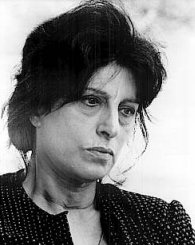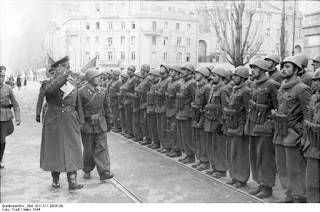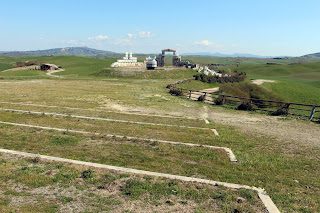Roman one of only three Italians to land best actor award
 |
| Anna Magnani, the Rome-born actress who died in 1973 |
Magnani had been quietly suffering from pancreatic cancer and her death at the age of just 65 shocked her fans and even close friends. Rossellini, with whom she had a tempestuous five-year relationship before he ditched her for the Swedish actress, Ingrid Bergman, was at her bedside along with her son, Luca. Rossellini was considered to be Magnani’s one great love. The American playwright Tennessee Williams, who wrote two parts for her in his plays (Serafina in The Rose Tattoo and Lady in Orpheus Descending) specifically with Magnani in mind, was so devastated he could not bring himself to attend her funeral.
Instead he sent 20 dozen roses to signify the bond they developed while working together over 24 years. When Williams was in Rome they would meet for cocktails on the roof-top terrace of her home, overlooking the city, always at eight o'clock - "alle venti" in Italy, where times are generally expressed according to the 24-hour clock. They would sign off letters and telegrams to one another with the words "Ci vediamo alle venti" or "See you at eight."
The funeral procession attracted crowds in the tens of thousands. Countless businesses closed and many streets were shut to traffic as Magnani's coffin was taken to the Basilica di Santa Maria Sopra Minerva, near the Pantheon in central Rome, where the service took place. The Piazza Minerva was thronged with people, who broke into spontaneous cheering when the coffin appeared.
 |
| The original movie poster for the film of the Tennessee Williams play |
Loren’s role was originally designed for Magnani and Loren was supposed to play the role of her daughter. Magnani refused to play opposite Loren, who was already 26 years old and not right for a teenaged virgin, and actually gave De Sica the idea to cast Loren as the mother; a role for which she would win the Best Actress Oscar in 1962.
Magnani's acting was notable in that she was able to bring her own personality, her affinity with the ordinary people she grew up with, to her roles, in which she was often cast as una popolana - a coarse woman of working class background. Raised largely by her grandparents in a poor, working-class part of Rome, Anna was a product of a short-lived marriage between her mother, Marina Magnani, and an itinerant Calabrian father (who worked in Egypt) whom she met only once.
Some erroneous biographical notes suggest she was born in Alessandria, Egypt but Magnani herself insisted that while her mother may have been in Egypt when she fell pregnant, she had moved back to Rome and was living in the Porta Pia area by the time she gave birth. Magnani was given her maternal surname, the last name of both her mother and grandmother.
While Anna had a tough upbringing in Rome, her grandmother managed to send her to a convent school, learned French, played piano, and, at age 17, went on to study at the Eleonora Duse Royal Academy of Dramatic Art in Rome for two years. She often said she felt more at home with the more down-to-earth people in her own neighborhood as it taught her to become streetwise at a young age. Magnani soon was supporting herself by singing in cabarets and nightclubs, where her performances drew comparisons with the French singer, Edith Piaf.
 |
| Anna Magnani, centre, in a scene from Rome, Open City, the film that was the turning point in her career |
Yet Magnani's career never faltered as it this very time, in 1949-50, that her friendship with American playwright Tennessee Williams would blossom. She went on to work with many of the great Italian directors, such as Luchino Visconti, Pier Paolo Pasolini and Federico Fellini, whose 1972 film, Roma, would be her last.
Magnani married Italian director, Goffredo Alessandrini, in the 1930s but they were together only briefly before the marriage was annulled. Her son, Luca, was born in 1942, the product of an affair with an Italian actor, Massimo Serato. Luca was stricken with polio as a child (1944) but Anna dedicated her life to caring for him in his younger years and providing him with the best (Swiss) medical care. Luca Magnani - Anna fought in court for him to keep her maternal surname - would go on to be a noted architect and real estate developer.
Luca Magnani's daughter, Olivia Magnani, born in Bologna in 1975, has followed her grandmother in becoming a movie actress. She is the fifth generation to carry on the Magnani name.
The stage play, Roman Nights, by Italo-American playwright Franco D’Alessandro recounts the inspired, fruitful, and tumultuous friendship between Anna Magnani and Tennessee Williams.
 |
| The beautiful vaulted ceiling of the Basilica di Santa Maria sopra Minerva in Rome |
The Basilica di Santa Maria sopra Minerva is the only existing example of an oroginal Gothic church in Rome, its Renaissance-style frontage concealing a Gothic interior featuring an arched vaulted ceiling painted blue with gilded stars. It contains a marble sculpture, Cristo della Minerva, by Michelangelo, and the strikingly beautiful Carafa Chapel, with frescoes by Filippino Lippi. Buried in the church are Saint Catherine of Siena, the Renaissance painter Fra Angelico, and at least four popes.
Travel tip:
Porta Pia, from which the neighbourhood in which Anna Magnani was born takes its name, is a gate in Rome's Aurelian Walls, designed by Michelangelo and named after Pope Pius IV. It was close to Porta Pia that a breach of the walls made by Bersaglieri soldiers from the north of Italy enabled Rome to be captured and completed the unification of Italy in 1870. It was also the scene of a failed assassination attempt on Benito Mussolini in 1926 by anti-Fascist activist Gino Lucetti.
Also on this day:
1997: St Francis Basilica struck by earthquake
Roberto Rossellini - father of neorealism
Federico Fellini - genius behind La Dolce Vita
Gina Lollobrigida - 60s sex symbol
More reading:
Roberto Rossellini - father of neorealism
Federico Fellini - genius behind La Dolce Vita
Gina Lollobrigida - 60s sex symbol

















